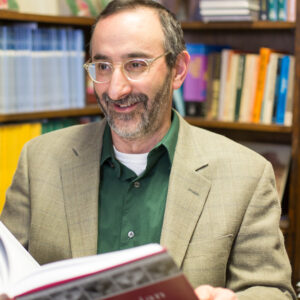
Who Wrote The Ten Commandments?
Feb 26, 2016 By Benjamin D. Sommer | Commentary | Ki Tissa
Where does our Torah come from? Did all the words of the Torah come from heaven, so that the Torah is a perfect divine work? If that is the case, then the tradition the Torah inaugurates is one that human beings should accept in its entirety without introducing any changes. Or is the Torah itself the result of human-divine collaboration? If that is the case, the tradition the Torah inaugurates may allow some change, at least by those Jews of each generation who accept the Torah and live by its commandments.
Read More
Bodies in Mirrors
Mar 1, 2003 By Lauren Eichler Berkun | Commentary | Ki Tissa
In the midst of an elaborate description of Bezalel’s artistic crafting of the Tabernacle, we read an unusual detail: “He made the laver of copper and its stand of copper, from the mirrors of the women who performed tasks at the entrance of the Tent of Meeting” (Ex. 38:8). This copper laver served as a basin for cleansing waters so that the priests could enter the Tabernacle in a state of ritual purity. Why would Bezalel craft such an important vessel from women’s mirrors? Why does the Torah mention this specific detail?
Read More
Actions with Consequences
Mar 10, 2007 By Matthew Berkowitz | Commentary | Ki Tissa
The Second Book of Samuel 12 is home to one of the most disturbing episodes of Tanakh. After King David’s reckless encounter with Batsheva and the murder of Uriah the Hittite, Nathan the prophet is sent by God to rebuke David. Nathan speaks in a biting metaphor, leading David in the direction of seeing himself as the guilty party of the parable. And just as Nathan concludes his story, he points his finger at David — informing David of his punishment: the sword will forever plague his household. What becomes shocking, though, is not the punishment that devolves on the shoulders of David, but rather the tragic end to the offspring of David and Batsheva.
Read More
A Radiant Face
Mar 18, 2006 By Matthew Berkowitz | Commentary | Ki Tissa
Coverings, especially of the face, are the theme of the hour in the Jewish calendar. The opening of this week began with our celebration of Purim. At the core of the holiday is the notion of hiddenness. God never explicitly appears in the entire ten chapters of the megillah; and the holiday is celebrated through festive costumes in which we mask, or cover, our true selves. This notion of covering continues thematically in this week’s Torah reading, Parashat Ki Tissa.
Read More
Listening to Anger
Mar 13, 2004 By Matthew Berkowitz | Commentary | Ki Tissa
Anger is a powerful emotion – propelling us toward constructive or destructive ends. The path to either of the latter however is chosen immediately in the aftermath of our fury. Will we simply be reactive in the moment and allow our wrath the power it seeks? Or will we rise above ourselves in an attempt to be self differentiated – to see the larger picture – and then act in a rational way? It is a moment pregnant with possibility. i.
Read More
Creation and Creativity
Feb 22, 2003 By Matthew Berkowitz | Commentary | Ki Tissa
When you sit down to center a piece of clay on the wheel, the first thing you must do is ‘center’ yourself — take a deep breath, let go of all extraneous thoughts, surrender control. You cannot force the clay into position with your hands or arms; rather, the message must emanate from your intellectual and emotional faculties: be quiet, be centered, be calm. To this, the clay responds.
Read More
Two Cows
Mar 2, 2002 By Lauren Eichler Berkun | Commentary | Ki Tissa | Shabbat Parah
There is a certain irony when parashat Ki Tissa falls on Shabbat Parah. In our weekly Torah portion, we read about the sin of the golden calf. In the maftir for this special Shabbat preceding Passover, we read about the ritual of the red heifer. Two cows on one Shabbat! One cow represents our complete abandonment of God a mere forty days after the revelation at Mt. Sinai. The other cow represents our ability to purify ourselves in the face of death and defilement.
Read More
What Did We Receive at Sinai?
Mar 14, 1998 By Ismar Schorsch | Commentary | Ki Tissa
At the end of the Torah reading in the synagogue, the scroll is spread and lifted so that everyone might see its hand-written script. Simultaneously, the congregation affirms out loud: “This is the Torah that Moses set before the people Israel; the Torah given by God, through Moses” (a composite of two verses, Deuteronomy 4:44 and a phrase repeated several times in the book of Numbers, 4:37,45; 9:23; 10:13). Having just finished a liturgical reenactment of the original national experience at Mount Sinai, we declare the text of this scroll to be the repository of that revelation.
Read More


